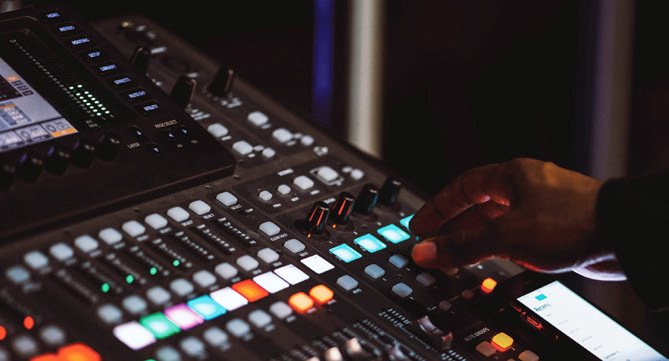
Over-Equalizing Inputs
When I’m asked by a student to help with their mix, the first thing I look at is EQ on the input channels. I often see a pattern of over-equalizing that can truly affect sonic quality. Some digital consoles offer four fully parametric bands of EQ along with a high- and low-pass filter, and quite frequently I notice that each band (low, low-mid, high-mid and high) is carved out pretty severely.
Before EQ’ing inputs, I always recommend starting with a well-tuned and optimized sound system. Once the tonal spectrum of the PA is balanced in the room, channel EQ should be minimal. If you find you’re pulling a bunch of low-mid from each vocal channel and the high-pass filters are all rolled up to 250 Hz, chances are that there’s too much of that in the PA system, so take care of it there first and then flatten out those vocal EQs.
When I see all four EQ bands cut, often the cuts have super-tight bandwidths with deep gain reduction. I like to imagine a seesaw when I consider channel EQ. If a guitar is too bright in the PA, try cutting a bit of high mid while boosting a bit of low mid. Use wider bandwidths and smaller boosts and cuts initially until you achieve a nice tonal balance. A bunch of cuts can rob the vocal or instrument of power and fidelity.
Too Dry Or Too Wet
Another common live music mix buster is the absence or overuse of effects (FX), including reverb, delay, and chorus/harmonizing, and the way they’re balanced with the mix of instruments and vocals. Under-utilizing vocal FX can leave a lead or background (BG) vocal poking way out of the mix and sounding stark (and occasionally pitchy), and a drum kit soaking in three seconds of hall reverb can feel distant and out of place alongside dry vocals and instruments.
I recommend shorter reverb times at first. A nice blend of a short or gated reverb and a slightly longer (one second) hall reverb on drums can add depth without the whole kit drowning. A single repeat delay and a touch of one-second reverb on a lead vocal helps it sit on top of the mix without separating it from the rest of the instrumentation.

Try a little bit of chorus or harmonizer on the BG vocals, along with a short, dark reverb and some well-spaced panning to pull them out of the center, providing the lead vocal space while the BG vocals form a nice warm cocoon around it. Also, use the high- and low-pass filters on the FX returns to remove unwanted lows and soften the highs so they sit back in the mix a bit and sound less “obvious.”
If some of the items I’ve covered here sound familiar, you’re not alone. I can confidently speak about them because I’ve learned a lesson each time I’ve made these same mistakes. Hopefully past mishaps turn into good habits moving forward, and all our mixes sound even sweeter.
